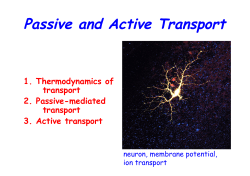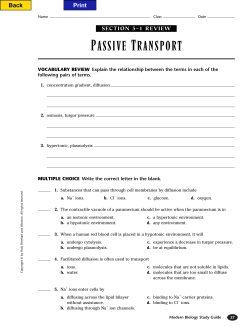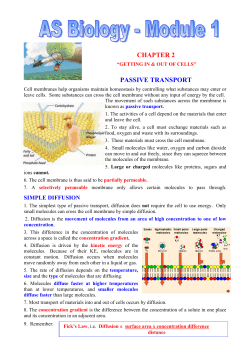
NEW HIGH RECOVERY REVERSE OSMOSIS WATER TREATMENT FOR
NEW HIGH RECOVERY REVERSE OSMOSIS WATER TREATMENT FOR INDUSTRIAL, AGRICULTURAL AND MUNICIPAL APPLICATIONS Author: Richard Stover Presenter: Richard Stover Executive Vice President – Desalitech, Inc. – USA rstover@desalitech.com Abstract Demand for water is high and global resources are limited. Reverse osmosis (RO) is an effective and widely-applied technology for water treatment and desalination, yet current RO systems waste both water and energy. This paper discusses how RO water treatment can be improved with closed circuit or semi-batch RO techniques. These new but proven processes increase water-use efficiency, reduce energy consumption, increase flexibility and reliability, and greatly reduce the emission of brine waste. Permeate recovery rates of over 97% can be achieved without multiple stages of membrane elements and without precipitation of sparingly soluble salts. High recovery, low energy, flexible performance is ideal for industrial water and effluent treatment, agricultural water supply, water reuse and inland brackish desalination. The author explains the theory behind this emerging technology and supports this analysis with case-study information from commercial closed-circuit RO systems that have been running for as long as 4-1/2 years. I. INTRODUCTION Industry accounts for nearly 60 percent of fresh water withdrawals in the developed world and agriculture consumes 70 percent of fresh water supplies globally, according to UNESCO [1]. This puts tremendous stress on water resources and drives fundamental and increasing need for more efficient and cost-effective water supply and wastewater treatment solutions. Reverse osmosis (RO) is an effective and widely-applied technology for water treatment and desalination, yet current RO systems waste both water and energy. High recovery water treatment and effluent reuse are the only sustainable and cost effective solutions. A new process is emerging that promises to improve nearly every aspect of RO performance [2,3,4,5,6]. Compared to conventional RO systems, semi-batch or closed-circuit (CCD) RO provides: • • • • • High adjustable recovery rates, Independently adjustable cross-flow Resistance to and even reversal of fouling and scaling Less energy consumption, and Fewer membrane elements and pressure vessels. High recovery operation reduces concentrate production, source water pumping and pretreatment requirements. High cross-flow, reduced lead element flux, more even flux distribution and salinity The International Desalination Association World Congress on Desalination and Water Reuse 2013 / Tianjin, China REF: IDAWC/TIAN13-429 cycling reduces the effects of fouling and scaling and the associated consumption of chemicals and membrane cleaning requirements. Reduced energy consumption and smaller membrane arrays save cost. These improved features are particularly beneficial for industrial water and effluent treatment, agricultural water supply, water reuse and inland brackish desalination applications. II. PROCESS DESCRIPTION CCD RO is based on principles employed by most non-RO filtration processes. All the water fed to the filters comes out in a product stream while contaminants are held back. Extra pressure is required to maintain steady product flow as contaminants accumulate, and periodically the system is flushed. CCD systems remove salts from water in exactly the same way. Product flow is equal to the feed flow and the feed pressure requirement increases as salt is retained by the RO membranes. Periodically the system is flushed, reducing the pressure requirement and restoring the system to its initial state. The CCD process for high-permeate-recovery operation (BWRO-CCD) is illustrated in the diagram below, with a single membrane pressure vessel representing multiple modules operating in parallel. A high pressure pump (HP) feeds a closed loop comprised of a single-stage of membrane elements and a circulation pump (CP). Permeate is produced at a rate equal to the flow rate of the HP. Brine is recirculated without depressurization. When a desired recovery percentage is reached, brine is throttled out of the system, displaced by feedwater from the high-pressure pump in a single plug flow sweep. The exchange of brine and feedwater is executed without stopping the high pressure pump or the production of permeate. The process then returns to closed-circuit operation, during which there is no brine reject stream. Figure 1. CCD RO Process Schematic Diagram For lower-recovery, higher-pressure applications, such as seawater desalination, an alternative CCD process is used to maximize energy savings. The SWRO-CCD process displaces spent brine with pressurized feedwater from a side conduit. The exchange, emptying and refilling of the side chamber is done under hydrostatic conditions with almost no loss of pressure energy. III. DESIGN AND MODELING The performance of CCD RO systems can be predicted using standard membrane projection programs and basic engineering design tools. These models estimate the pressure requirements and permeate quality output of CCD RO systems in the same way they do for conventional RO systems. These models can also be used to study the performance of individual membrane elements in multi-element arrays. Multiple flows, recoveries and membrane configurations can be examined in the model to test the flexibility of alternative systems. The warnings generated by the projection programs identify operating The International Desalination Association (IDA) World Congress on Desalination and Water Reuse REF: IDAWC/TIAN13-429 -- 2 -- limits. Specifically, this experimental modeling approach can give an indication of when lead membrane element flux is high, thereby predicting when these elements are at greatest risk of fouling. It can indicate when cross-flow is low, thereby identifying excess concentration polarization and the associated risk of fouling and scaling. It can also allow consideration of how feed composition and temperature changes affect system performance. Such studies are well-documented in referenced papers [7,8,9]. The benefits provided by CCD RO systems anticipated by modeling analysis are borne out in field installations as described below. IV. CASE STUDIES CCD systems are at work in a range of applications from sea and brackish water desalination to wastewater reuse and ultrapure water production. The following are selected examples of these installations and their key performance characteristics. 4.1 Integrated Industrial Water Treatment Solution An industrial water treatment system was needed to achieve high recovery for maximum utilization of a limited groundwater source. The CCD unit, installed in October 2012, is producing 0.2 MGD or 600 m3/d of permeate from a 3,500 ppm brackish well. The treatment process includes ultrafiltration, activated carbon treatment and RO. A recovery rate of 90% has been sustained despite a fairly heavy mineral loading in the feed water. Figure 2. Industrial Water Treatment System 4.2 High Recovery Flexible Agricultural BWRO A brackish water treatment system was needed to produce desalinated irrigation water for a farm. The farm is not close to the sea, so high recovery was necessary to minimize brine disposal infrastructure and The International Desalination Association (IDA) World Congress on Desalination and Water Reuse REF: IDAWC/TIAN13-429 -- 3 -- costs. The 0.2 MGD / 800 m3/d CCD system began operation in February 2009. At startup, the feedwater had a conductivity of 4,000 μS/cm and the CCD system operated at 88% recovery. However, as extraction of the water continued, the feed conductivity increased to 8,500 μS/cm. Because the highpressure pump had been sized for a maximum pressure of 22 bar / 320 psi, a maximum of 80% recovery could be reached. The CCD system was able to reduce its recovery rate and continue to operate at up to the maximum pressure capability of the pump without reducing flux or permeate production. Figure 3. Brackish Water Desalination for Irrigation Water 4.3 High Recovery Low Energy Municipal BWRO A municipal RO system was needed to produce drinking water from a 6,800 μS/cm brackish groundwater source at maximum recovery to make the most efficient use of the limited groundwater supply. The plant, sized for 0.4 MGD or 1,400 m3/d of permeate output, went into operation in October 2010. It maintains 90% recovery and consumes just 0.55 kWh/m3 of electrical power with its highpressure and circulation pumps. The International Desalination Association (IDA) World Congress on Desalination and Water Reuse REF: IDAWC/TIAN13-429 -- 4 -- Figure 4. Brackish Water RO for Municipal Water Supply 4.4 High Recovery Low Fouling Municipal Wastewater Reuse Treated municipal wastewater effluent is an important source of water supply for indirect potable use in Singapore. A 20 gpm / 156 m3/d CCD demonstration system was commissioned in February 2013 to purify tertiary treated effluent. It currently operates at 85% recovery with a single stage of membrane elements. The unit’s resistance to fouling and bio-fouling is currently being investigated. This project will be run for 18 months. Figure 5. Water Reuse from Municipal Effluent The International Desalination Association (IDA) World Congress on Desalination and Water Reuse REF: IDAWC/TIAN13-429 -- 5 -- 4.5 Standard Pilot Unit for Flexible Application A pilot unit was designed for maximum flexibility. It has been operated at recovery rates ranging from 70 to 93% from a 1,000 ppm TDS wastewater source. It has also been operated at up to 97.3% recovery from first-pass RO permeate. This pilot unit demonstrates the possibility of employing a standard pilot unit to operate on a broad range of source waters. Figure 6. Flexible Pilot Unit 4.6 Record Low Energy Consumption SWRO Demonstration The 44 gpm (250 m3/d) CCD unit for seawater RO was operated in Mediterranean seawater with an average salinity of 4.1% and a temperature in the range of 22-32 degree C [10]. A range of recovery rates from 40-53% and fluxes from 5 to 15 gfd (8 to 26 lmh) were tested. Specific energy consumption by the high-pressure pump and circulation pump was measured in the range of 1.7 to 2.6 kWh/m3. The corresponding specific energy consumption normalized to 45% recovery operation at 7.5 gfd (14.3 lmh) flux from standard seawater of 35,000 ppm TDS is 1.6 kWh/m3. This very low energy consumption rate compares very favorably with the energy consumption rates of state-of-the-art SWRO systems which typically range from 2 to 3 kWh/m3. The International Desalination Association (IDA) World Congress on Desalination and Water Reuse REF: IDAWC/TIAN13-429 -- 6 -- Figure 7. Seawater RO for Municipal Drinking Water 4.7 High Recovery Industrial Water Treatment A CCD system was built as a demonstration unit for industrial water treatment at a facility in the United States. It produces 50 gpm at 92% recovery with a single stage of membrane elements. The unit runs alongside a conventional 2-stage RO system operating at 75% recovery. The higher recovery rate of the CCD system reduces brine discharge to the sewer by a factor of three. Despite the small size of the system, the cost savings associated with reduced brine disposal fees amounts to almost $43,000 per year savings. In addition, the CCD system consumes less energy than the conventional system despite its higher recovery rate. Figure 8. Industrial Water Treatment The International Desalination Association (IDA) World Congress on Desalination and Water Reuse REF: IDAWC/TIAN13-429 -- 7 -- V. DISCUSSION The case studies above illustrate how CCD RO can provide better performance and cost savings compared to conventional RO systems. These advantages and how they are achieved are further discussed in this section. 5.1. Increased Recovery The overall recovery rate in a CCD process is a function of the intrinsic volume of the system and the volume fed over the course of a sequence, the latter being flexible. Therefore recovery is flexible and can be set at the system control panel. Being able to achieve high recovery in a single stage is a novel capability with beneficial implications for system cost and design and operational simplicity. It is not necessary to use multiple stages or six- to eight-element-long membrane arrays to achieve high recovery as is necessary in conventional RO processes. A high-recovery CCD process can be constructed with just one membrane element, for example. More typically, CCD membrane arrays consist of three or four elements, numbers which have been found to optimally balance performance and costs. CCD systems have achieved over 97% recovery whereas traditional RO systems typically operate at only 75% recovery. Modeling analysis shows that individual BWRO-CCD systems can be designed to operate well, producing high quality permeate with low energy consumption, over a recovery range of 75 to 98% recovery. SWRO-CCD systems offer even greater energy conservation and a larger recovery range, from 40 to 98%. 5.2. Energy Savings The initial pressure requirement of each CCD sequence is proportional to the osmotic pressure of the feedwater and the maximum is proportional to the osmotic pressure of the final brine, the same pressure as the running pressure of a conventional RO stage. The resulting average membrane feed pressure in the CCD process is much lower than the feed pressure of typical RO systems. Lower feed pressure means lower pump energy requirements and tremendous energy savings. CCD systems also dramatically reduce energy loss to the brine reject stream by reducing its pressure prior to release. As described above, CCD systems can desalinate seawater with 1.6 kWh/m3 energy, compared to 2 to 3 kWh/m3 with state-of-the-art conventional RO. Similarly significant savings are achieved with CCD systems in industrial water and effluent treatment applications, for which 35% reductions in energy consumption are typical. 5.3. Fouling and Scaling Resistance Good resistance to fouling and scaling and high recovery operation are important in most brackish water desalination, industrial water treatment and water reuse applications. CCD systems provide new or enhanced means for addressing these challenges. Cross flow supplied by a circulation pump washes the membranes and reduces the effects of scaling and fouling. Although a CCD process can be operated at higher average flux rates than conventional RO processes, the more balanced flux distribution that is inherent with shorter membrane arrays limits the maximum flux and recovery experienced by each individual membrane element. In particular, the flux through the first or head element in each membrane The International Desalination Association (IDA) World Congress on Desalination and Water Reuse REF: IDAWC/TIAN13-429 -- 8 -- housing in a short membrane array is less than that in a long membrane array with the same average flux. This helps reduce head element fouling. As the salinity throughout the CCD process cycles from that of the feedwater to that of the most concentrated brine, biofilm formation and scale precipitation are disrupted. Recovery rates of over 90% have been achieved and maintained from water sources with high concentrations of silica and calcium sulfate, producing brine concentrations of these constituents that are four times higher than can be sustained in conventional RO processes [11]. 5.4. Simplified Design and Flexible Operations In conventional RO plants, recovery, cross flow and flux are all supplied by the high-pressure pump and are interdependent. The CCD process decouples the basic variables of the RO equation, enabling independent manipulation of these functions. The resulting extreme operational flexibility allows the RO process designer and operator to cope with variations in feedwater quality and customer requirements, optimize process performance and minimize costs. 5.5. Cost and Footprint Reduction High recovery operation means reduced feedwater pretreatment requirements, and this can reduce the cost and footprint of the installation. In the CCD process, two 4-membrane element arrays can be housed in a single center-port pressure vessel fed from both ends, with brine take-off from a center port. This center-port configuration can result in fewer pressure vessels than are required for a comparable conventional RO process, reducing footprint. Also, because CCD systems can often be designed to operate at higher flux than conventional RO systems, fewer membrane elements can be required, further reducing footprint. VI. CONCLUSIONS Reverse osmosis water treatment costs can be lowered by increasing water-use efficiency, reducing energy consumption and increasing flexibility and reliability. A new CCD configuration of standard RO equipment and membranes can enable permeate recovery rates of over 97% without multiple stages of membrane elements and without precipitation of sparingly soluble salts. These systems can operate with 35% less energy than conventional RO systems by significantly reducing average feed pressure requirements and by eliminating or reducing brine pressure within the process prior to discharge without the use of energy recovery devices. Good resistance to fouling and scaling and automatic adaptation to small or large changes in feedwater quality lower operations and maintenance costs. This performance is ideal for industrial water and effluent treatment, agricultural water supply and inland brackish desalination and represents major improvements in RO performance and economics. VI. REFERENCES UNESCO (2003), Water for People, Water for Life, United Nations World Water Development Report, United Nations Educational, Scientific and Cultural Organization. 2. Efraty, A. (2010a), US Patent No 7,628,921. 3. Efraty, A. (2010b), US Patent No 7,695,614. 1. The International Desalination Association (IDA) World Congress on Desalination and Water Reuse REF: IDAWC/TIAN13-429 -- 9 -- 4. 5. 6. 7. 8. 9. 10. 11. Efraty, A. (2012), Closed Circuit Desalination Series No-4: High Recovery Low Energy Desalination of Brackish Water by a New Single Stage Method without any loss of Brine Energy, Desalination and Water Treatment, v42, pp. 262–268. Efraty, A. and Z. Gal (2011), Closed Circuit Desalination Series No 7: Retrofit Design for Improved Performance of Conventional BWRO System, Desalination and Water Treatment, in press 2011. Efraty, A., R. Barak and Z. Gal (2011), Closed Circuit Desalination — A New Low Energy High Recovery Technology without Energy Recovery, Desalination and Water Treatment, v31, pp. 95101. Stover, R. (2012a), Industrial and Brackish Water Treatment with Closed Circuit Reverse Osmosis, Proceedings of the European Desalination Society Meeting in Barcelona Spain, Paper number 386, April. Stover, R. (2012b), Evaluation of Closed Circuit Reverse Osmosis for Water Reuse, Proceedings of the 27th Annual Water Reuse Symposium in Hollywood, FL, September. Stover, R. (2013), Permeate Recovery and Flux Maximization in Semi-Batch Reverse Osmosis, accepted for publication in IDA Journal of Desalination and Water Reuse. Stover, R. and N. Efraty (2011), Record Low Energy Consumption with Closed Circuit Desalination, Proceedings of the International Desalination Association World Congress Meeting in Perth Australia, Paper Number 375, October. Tarquin, A. and G. Delgado (2012), Concentrate Enhanced Recovery Reverse Osmosis: A New Process for RO Concentrate and Brackish Water Treatment, Proceedings of the American Institute of Chemical Engineers Meeting in Pittsburg, PA, paper number 272277, October. The International Desalination Association (IDA) World Congress on Desalination and Water Reuse REF: IDAWC/TIAN13-429 -- 10 --
© Copyright 2025





















